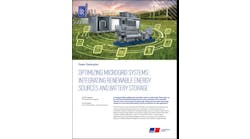When John Caldwell of the Edison Electric Institute began a microgrid task force a few years ago, the utilities that joined saw no need to meet more than annually. Now they want to meet monthly, reflecting what Caldwell sees as exponential growth in utility microgrids.
“Active utility involvement in terms of partnering was probably less than 10 percent in 2014. As of mid-2017, it was 40 percent,” said Caldwell, who serves as EEI’s director of economics.
Or as Southern Company’s Howard Smith put it, “Welcome to the evolution.”
Caldwell and Smith discussed utility microgrids on a panel at the Microgrid Global Innovation Forum, hosted in Washington, D.C. last week by Smart Grid Observer. Other panelists were Eric Stein, manager of R&D and new technology programs, Exelon/PECO and Charles Hookham, director ofproject management and engineering, CMS Energy.
The panelists said utilities want to develop microgrids — or partner with those who are — but are frustrated with a regulatory system that dampens utility innovation.
“Regulatory constraints prevent us from doing a lot of things that make sense,” said Stein. “That’s not because our regulators are bad people; it’s just that our framework is antiquated, and things are changing. Some states are more out in front, like New York, Connecticut and California. And other states not so much.”
New drivers for utility microgrids
In the past, change in the utility industry stemmed from state and federal mandates. But this “evolution” is different, added Smith, who serves as Southern Company’s manager of distributed energy resources policy.
“This is a customer driven, technology driven evolution,” he said. “Customer needs are different because they are digital. Their expectations are greater. Their information and knowledge are greater.”
Join us to explore the new age of microgrids with leading utility executives at Microgrid 2018, May 7-9 in Chicago
What stops utilities from readily meeting those needs? One problem, said the panelists, is a requirement that utilities use volumetric pricing, meaning they are paid based on the volume of electricity they sell.
Smith said he envisions a future, perhaps 5, 10 or 15 years from now, when volumetric rates disappear and electric utilities instead sell services, such as lighting, space conditioning or resiliency. In that world, utilities will be able to “customize to the needs of the customer and the needs of society.”
To get there, the utility industry needs to stop thinking in terms of the electric meter, he said.
In fact, Smith described as “arcane” the terms “behind-the-meter” and “in-front-of-the-meter,” which now often denote customer versus utility generation. The grid is not so easily segmented anymore. What utilities now manage extends from the generating plant to the “toaster,” he said.
“That’s where the challenge comes in. How do you manage and operate this? What level of service as a customer do you want? What level of reliability and sustainability are you willing to pay for?” Smith said.
Insomnia brought on by microgrids
CMS’ Hookham said his company helps customers develop microgrids — but it’s not always easy.
“We work as a team and come up with a solution,” he said, adding: “I’m a little bit concerned about the issues people don’t think about. I lose sleep at night because my customers think these can be done instantaneously and don’t understand all of the implications.”
Microgrid projects can be derailed by such issues as lack of compliance with codes and standards, high insurance premiums and compatibility with IT cybersecurity systems, Hookham said.
Preparing for that future, utilities are now testing various models and technologies to sort out the issues.
Southern, for example, has residential microgrid and solar demonstration projects underway in Atlanta and Alabama. Lessons learned so far? Smith said that Southern is collecting data on 62 smart homes in Alabama participating in the project, and so far they are delivering on creating a flatter, less “spikey” load profile.
In Atlanta, the utility learned the importance of educating architects. This occurred after town home designs emerged that could not accommodate solar and high efficiency heat pumps.
Southern also is working on what may be a first of its kind urban microgrid in downtown Atlanta near Georgia Tech. Part of an innovation center region, the microgrid will be an “evolving, living” project with technology periodically updated to test new approaches. The project is unusual in that the microgrid will serve a network distribution system, rather than a radial system.
We’re doing all of this because we want to learn the unexpected,” Smith said. “What keeps me up at night is not the things that I know I don’t know. It’s the things that I don’t know that I don’t know.”
Read more on the Microgrid Knowledge channel dedicated to utility microgrids.






